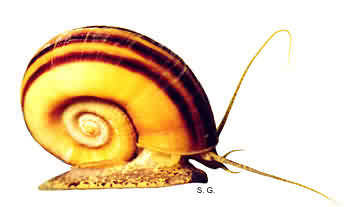
(Linnaeus, 1758)
 |
(Linnaeus, 1758)
|
Shell: 3.5-4 whorls; older snails
have a planorboid shell (the spine isn't elevated above the body whorls, making
the shell almost 'flat'); young snails have an elevated spine, making them globose-shaped;
18-22 mm wide, 48-56 mm high; pronounced growth lines (transverse stria) on
adult shells near the aperture; aperture plane makes a slight angle with the
shell axis (10°).
Colour: Dark yellow to brownish ground colour with dark brown or even black
spiral bands. The 3 to 6 dark spiral bands are not present on the spine of the
shell, but are mainly located at the umbilicus. The result of this unequal-banding
pattern is that these snails often have a yellow and a black side.
A mutation, in which the banding pattern is absent, exists. These snails have
a completely yellow shell.
|
Interactive 3D-models (Java): |
Operculum: The thin operculum is smaller than the shell opening and can thus be retracted completely into the shell.
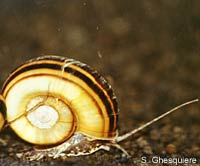 Marisa cornuarietis. |
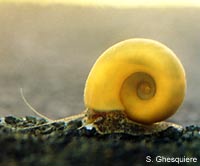 A yellow Marisa cornuarietis, a cultivated variant that lacks the typical banding of this species. |
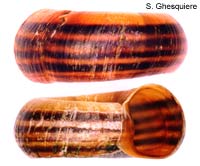 Marisa cornuarietis shell. |
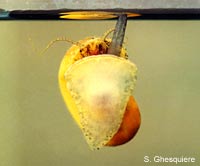 Often overlooked, but Marisa cornuarietis, also has a breathing siphon, although much shorter than in the Pomacea species. |
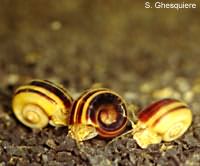 A sinistral Marisa cornuarietis at the right: its spine/shell top is located at the left side of the body instead of at the right side. |
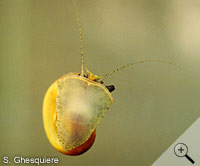 Marisa cornuarietis snail on the glass. |
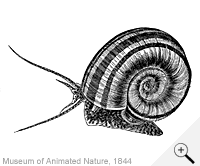 Marisa cornuarietis. From Charles Knight's "The Pictorial Museum of Animated Nature" (London: 1844), p. 216. (picture not licenced under creative commons) |
Body: Yellow to grey with darker pigment spots over the whole body.
|
Interactive 3D-models (Java): |
Eggs: Laid below the water surface on the vegetation,
packed in a gelatinous clutch. The size of the eggs is about 2 to 3 mm when
deposited.
The eggs are visible as small white spots inside the transparant gelatinous
mass that surrounds them.
During the development of the little snails, the eggs swell considerable (up
to 4 mm). They also become more transparant and the little snails become visible
as little spots attached at the inside wall of each egg.
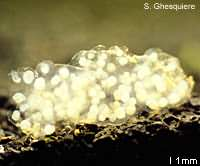 Eggs in gelatinous mass, Marisa cornuarietis, 2 days old. |
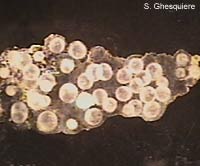 After 10 days: the eggs have increased in size. The little snails are attached to the walls of each egg. |
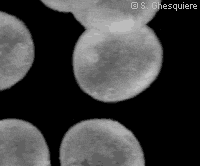 The young Marisa cornuarietis snails already walk inside the eggs days before hatching (here at 10 days). Note that the movie plays at 5x speed. |
Food: These snails eat almost everything they can get (omnivores): dead
and rotting plants, many types of fresh plants, dead animals, eggs of other
animals; voracious eaters. Not suited for planted aquaria.
Behaviour: Lives in lakes, ponds, irrigation systems and swamps. These
snails stays close to the surface and prefer shallow waters with a lot of vegetation.
They are known to tolerate relatively high salt concentrations and they are
occasionally found in light brackish-waters. They are able to survive in these
brackish waters, but they do not reproduce under these conditions. In literature
(Hunt, 1961; Robin, 1971; Santos et al., 1987), it's reported that Marisa
cornuarietis can withstand a salinity up to about 30% salt water.
In general, the temperature may not drop below 12°C for prolonged periods for
these snails to survive.
Distribution: Brazil, Columbia, Venezuela, Panama, Costa Rica and Honduras;
due to the aquarium trade and also it's use for controlling aquatic vegetation,
the snail has spread to other tropical regions as well. Marisa cornuarietis
appeared in Cuba in the late 1940' and in Puerto Rico in 1952. In the 1970's
the snail invaded Florida (USA) and later on (1990's) the state of Texas (USA).
Recommended web resources:
Another page about these snails is made by Renate Husmann (in German):
http://www.rhusmann.de/aqua/marisa.htm.
For other links to Marisa cornuarietis sites: the link section.
|
Except where otherwise noted, this page is licensed under a Creative Commons Attribution-NonCommercial-ShareAlike 2.5 License . http://www.applesnail.net |
|